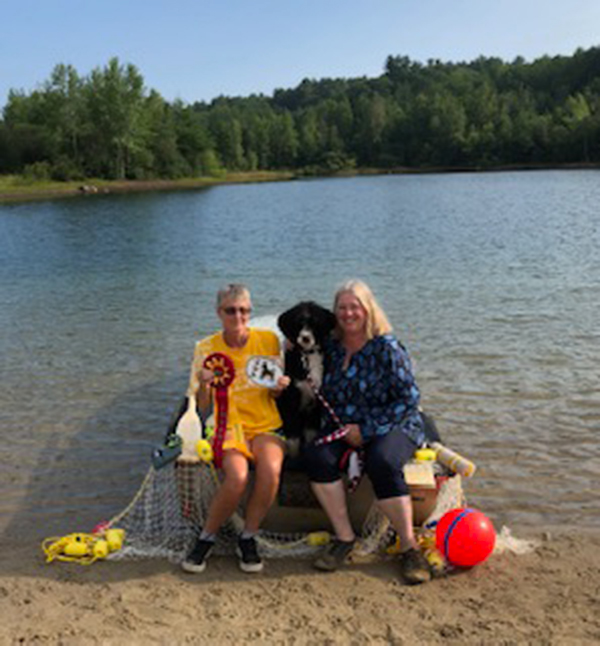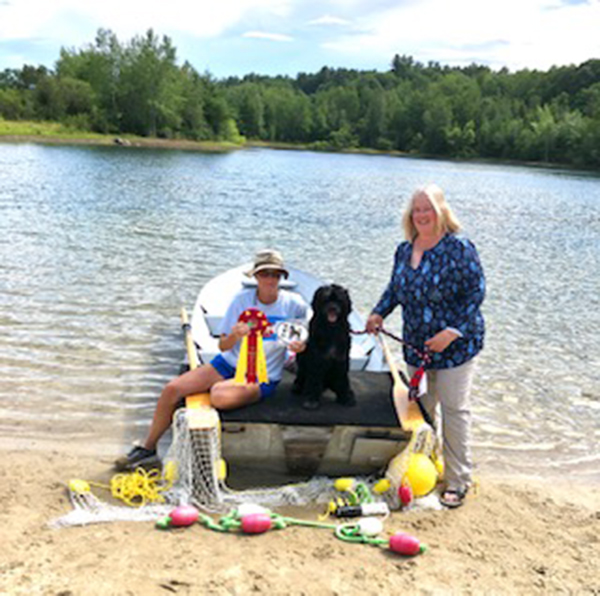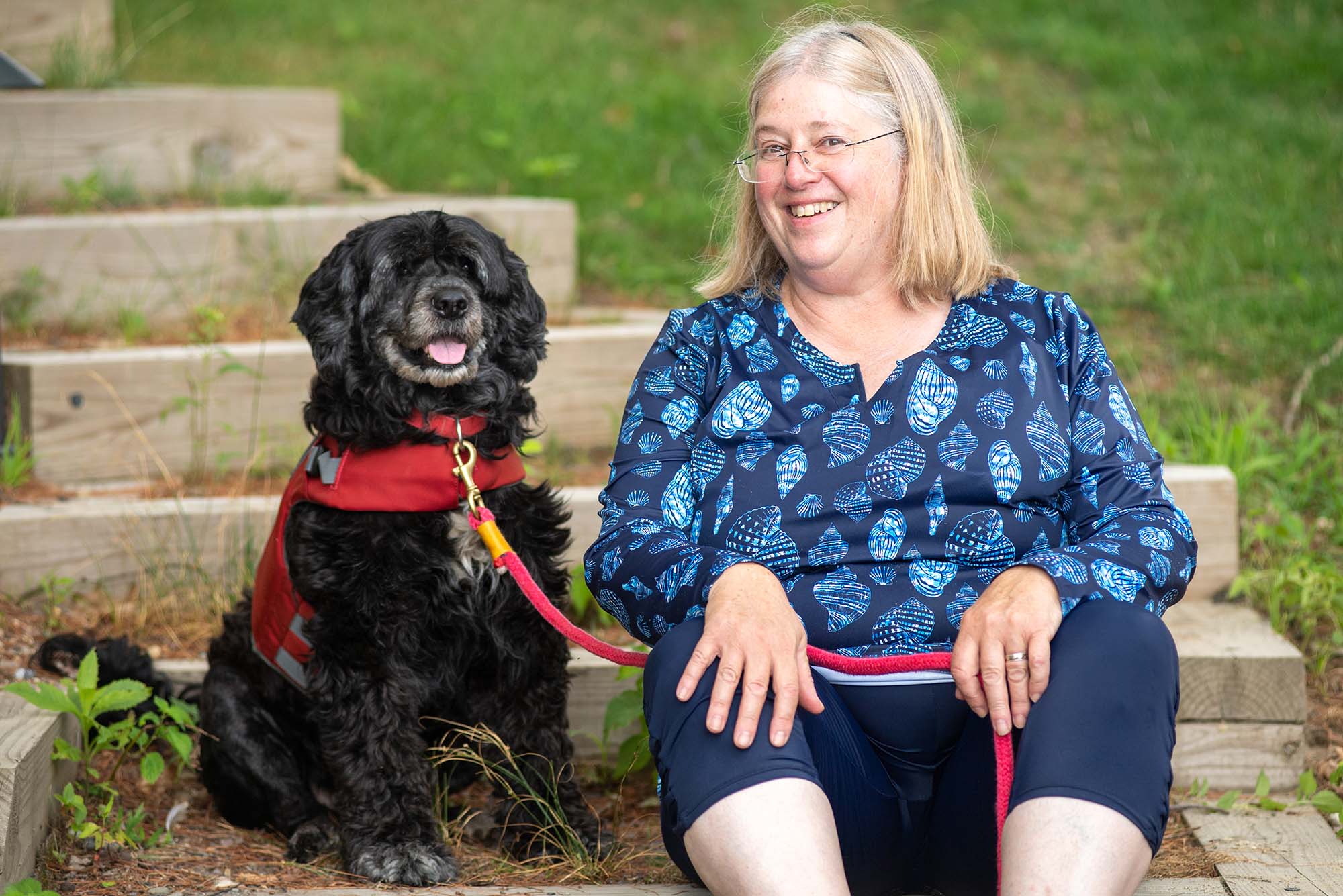Teaching Dogs to Jump off a Boat—and Ignore the Ducks
CGS prof Kari Lavalli is also an award-winning dog trainer and breeder
Teaching Dogs to Jump off a Boat—and Ignore the Ducks
Teaching Dogs to Jump off a Boat—and Ignore the Ducks
Bell can’t wait to leap into the water. Perched on a boat, she paces in anticipation as two bumpers are thrown in on either side of her. The boat rocks slightly, and her coach finally tells her which one to dive for first. On command, she leaps into the water, gets confused, but quickly corrects. Her reward? High verbal praise, followed by chunks of frozen meatballs.
A Portuguese water dog, Bell belongs to Kari Lavalli (GRS’92), a College of General Studies master lecturer in natural sciences and mathematics and department chair, and an award-winning dog trainer and breeder. When she’s not in the classroom, Lavalli is likely working with dogs of all levels on agility (both in the water and on land), as well as obedience.
A teacher first, Lavalli is quick to note the similarities between working with pups and with college kids, and the enjoyable challenge of showing both kinds of students that a problem isn’t as complicated as it may seem at first. “How can I break the problem down? Does the dog understand what I want?” Lavalli asks. “It’s kind of like teaching students, because the student is trying to understand something like a biochemical reaction, and your job is to break it down into little pieces and then build it back up for them.”
Fishermen used to train Portuguese water dogs to retrieve tackle that fell overboard, herd fish into nets, swim between boats and shore with messages, and guard catch. Their wide, webbed paws and thick, curly, water-resistant coat make them especially strong swimmers. While the majority of Portuguese water dogs today are kept as pets—President Obama and the late Massachusetts Senator Ted Kennedy (Hon.’70) were both owners—the breed excels at agility work and is described by the American Kennel Club as eager-to-please, super-smart, and athletic.
Water training is a short, intense season, Lavalli says, running roughly from late May to September, and concludes with two water trials. In competition, dogs must perform exercises like retrieving gear bags, bumpers, float lines, and buoy balls, swimming to and boarding a boat from the shore, and setting nets from one boat to another. The exercises mimic the tasks fishermen would require of their dogs.
There are five levels of water work: junior, apprentice, working, courier, and master. Dogs don’t compete against one another for these titles; instead, if they pass every exercise at their level, they are awarded a certificate or title. Only about 35 percent of dogs pass their test the first time, according to the Portuguese Water Dog Club of America. Those that don’t can test again.
Lavalli coaches a group of trainers and their dogs on a pond in Bolton, Mass., for several hours at least once a week to prepare for the test. On a recent hot summer day, a friend rows while Lavalli sits at the back of the boat, her feet dangling in the water. Seated next to her is Bell, wearing a life vest and a lobster-themed dog collar (Lavalli has spent her career studying different species of lobsters all over the world). She has brought eight-year-old Bell to the courier titling level, the second highest awarded by the Portuguese Water Dog Club, traveling with her to competitions all across New England. “She’s a superior, tough dog, and pushy about training,” Lavalli proudly says.
When she gives Bell the command to swim to shore, the dog leaps off the boat and starts moving. But she gets distracted. Wind, rain, sun glare, and currents can complicate every task, not to mention (fun) distractions like lily pads, ducks, and beavers.


Lavalli with two of her dogs after this summer’s competition: Streak (left, black and white dog) passed the Junior Water Dog trial on his first try. Scully (right) earned her Working Water Dog leg 2, but she needs 3 legs for Working Water Dog excellent. Photos courtesy of Lavalli
Bell climbs back on board and they wait a minute before trying again. This time, she jumps and swims swiftly to shore, grabs a fishing line from the beach, and makes her way back to the boat. “Excellent job, what a good girl,” Lavalli says in a firm, encouraging tone. “Very nice work.” After 15 years of training, very little fazes her.
Patrice Lattrell drives her dog three and a half hours to train with Lavalli. Portuguese water dogs, “are thinking dogs, they like being right,” Lattrell says. “And when Kari corrects them, she’s very positive, very upbeat. Dogs respond to that.”
“She’s built a community of dogs and trainers,” adds friend Phyllis Zusman. “She’s supportive and patient.”
While Lavalli has owned 10 dogs over the years, she didn’t begin dog training work until 2007, when a former colleague offered her a female Portuguese water dog puppy, Asta. The colleague asked that Lavalli train and compete with the dog, and she agreed. “Asta was more like a Portuguese wading dog, because she would go in the water, but not really swim,” Lavalli says with a laugh. “So we did obedience instead—rally, scentwork, barn hunt.” Lavalli then worked with Asta’s son Darwin. “He was a great dog, but he was a difficult dog. He taught me a lot about training,” she says.
A lot of training involves working on fundamental skills that casual pet owners also teach—like retrieving and coming on command, she says, but at a higher intensity level, with more distractions thrown in. “And all dog trainers will say that you’re training the person how to train their dog. Most dog trainers can train the dog faster than the person that they’re trying to teach.”
Whereas it might take the average person a few days to teach their puppy how to shake a paw, Lavalli can do it in about six minutes. “I am looking for certain behaviors,” she says, “the slivers that get you the final behavior.” As an example, she talks about retrieving, a skill that has many components. First, the dog has to put its mouth on what it’s retrieving, then hold it (one of the hardest skills to teach), keep holding it while in motion, and then bring it to the trainer’s hand. Timing is key, and trainers must mark exactly when the dogs have done the thing they want them to do.
“Fortunately, dogs are extremely forgiving, and they can sort of bridge,” she says. “If your timing is bad, they can figure out, oh, she didn’t really mean ‘Yes’ when I sat, she meant ‘Yes’ when I stood.”
Even casual pet owners can heed this advice. Training a dog in scent work or agility or tricks “makes your dog want to work with you more, and makes your dog pay more attention to you,” Lavalli says, “as opposed to a dog who just goes outside, comes in, and gets fed and petted. A trained dog can pretty much go anywhere. It helps your dog have a lot more freedom.”
Bottom line: “The more you train your dog, the better relationship you’ll have.”

Comments & Discussion
Boston University moderates comments to facilitate an informed, substantive, civil conversation. Abusive, profane, self-promotional, misleading, incoherent or off-topic comments will be rejected. Moderators are staffed during regular business hours (EST) and can only accept comments written in English. Statistics or facts must include a citation or a link to the citation.